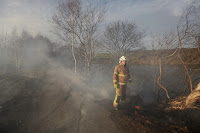Production at the Boulby Potash Mine in North Yorkshire, England, following an explosive gas outburst which killed a worker at the site on Friday 17 June 2016. The miner has been named as John Anderson, 56, though further details of the incident are not yet availble. The mine is operated by Cleveland Potash Limited a UK subsidiary of Israel Chemicals Ltd.
The Boulby Potash Mine. Gazette Live.
Gas explosions typically occur in mines when miners hit pockets of gas, in potash deposits typically carbon dioxide (CO₂). Typically when a seam containing pressurized gas is cut into
it bursts, releasing the pressure and throwing large blocks of rock into
the faces of the miners, often with fatal results. Thus although the
gas involved is flammable it does not actually need to ignite to cause
fatalities.
Potash (potassium salt) is an important mineral in the production of
commercial fertilizers. The Potash deposits of northeast England, as with most European salt deposits, were laid down during the drying of the
Zechstein Sea. The Zechstein was an ancient inland sea in northern
Europe, that evaporated away during the Middle to Late Permian, leaving
vast mineral deposits that are excavated as far away as Germany and Poland. Because different ions have different properties they are
precipitated out in a sequence as seawater evaporates, which does not
show on a small scale, but which can produce distinct, workable, layered
deposits when a body as large as the Zechstein evaporates.
The potash deposits of these Zechstein deposis are
contained between layers of limestone, in an area that has suffered
injections of volcanic material since the time of deposition. Heating
limestone (CaCO₃), in this case by injecting hot magma into seems
running through the limestone beds, causes it to release large amounts
of carbon dioxide (CO₂), which in this case has become trapped in
pockets within the salt deposits. Miners working these deposits need to
take precautions against this, and carefully monitor the levels of
carbon dioxide within the salt, though it appears on this occasion they
were caught out.
See also...
 Underground fire at former coal mine near Gateshead, England. The Tyne and Wear Fire service
are investigating a possible underground fire at the site of the former
Clara Vale mine workings. The fire is not thought to present any hazard
to the public, but part of a local...
Underground fire at former coal mine near Gateshead, England. The Tyne and Wear Fire service
are investigating a possible underground fire at the site of the former
Clara Vale mine workings. The fire is not thought to present any hazard
to the public, but part of a local... Two rescued from disused mine in Ceredigion, Wales. Two men described as being in their seventies were rescued from the disused Bwlch Glas Mine near Talybont in Ceredigion,
Mid Wales, at about...
Two rescued from disused mine in Ceredigion, Wales. Two men described as being in their seventies were rescued from the disused Bwlch Glas Mine near Talybont in Ceredigion,
Mid Wales, at about... Worker killed at Irish lead and zinc mine. A worker was killed in a partial collapse at the Lisheen Mine in Tipperary, Ireland at about 4.40 pm on Thursday 4 April 2013. The
man has bee named as Mario Francis, a married father of two in is
forties, who had worked at the mine for twelve years and came...
Worker killed at Irish lead and zinc mine. A worker was killed in a partial collapse at the Lisheen Mine in Tipperary, Ireland at about 4.40 pm on Thursday 4 April 2013. The
man has bee named as Mario Francis, a married father of two in is
forties, who had worked at the mine for twelve years and came...
Follow Sciency Thoughts on Facebook.

